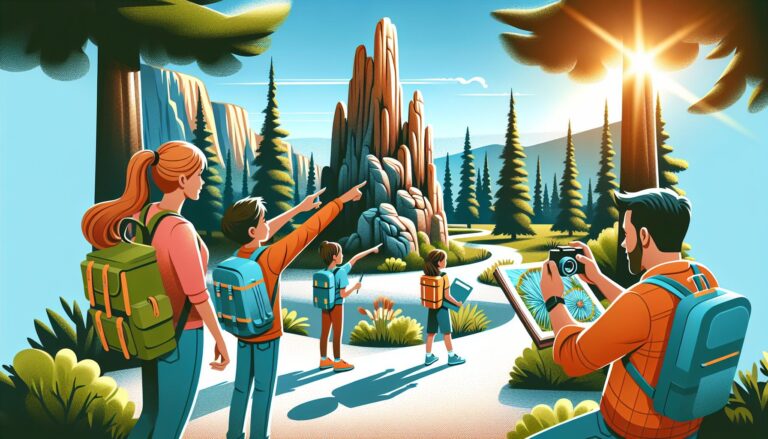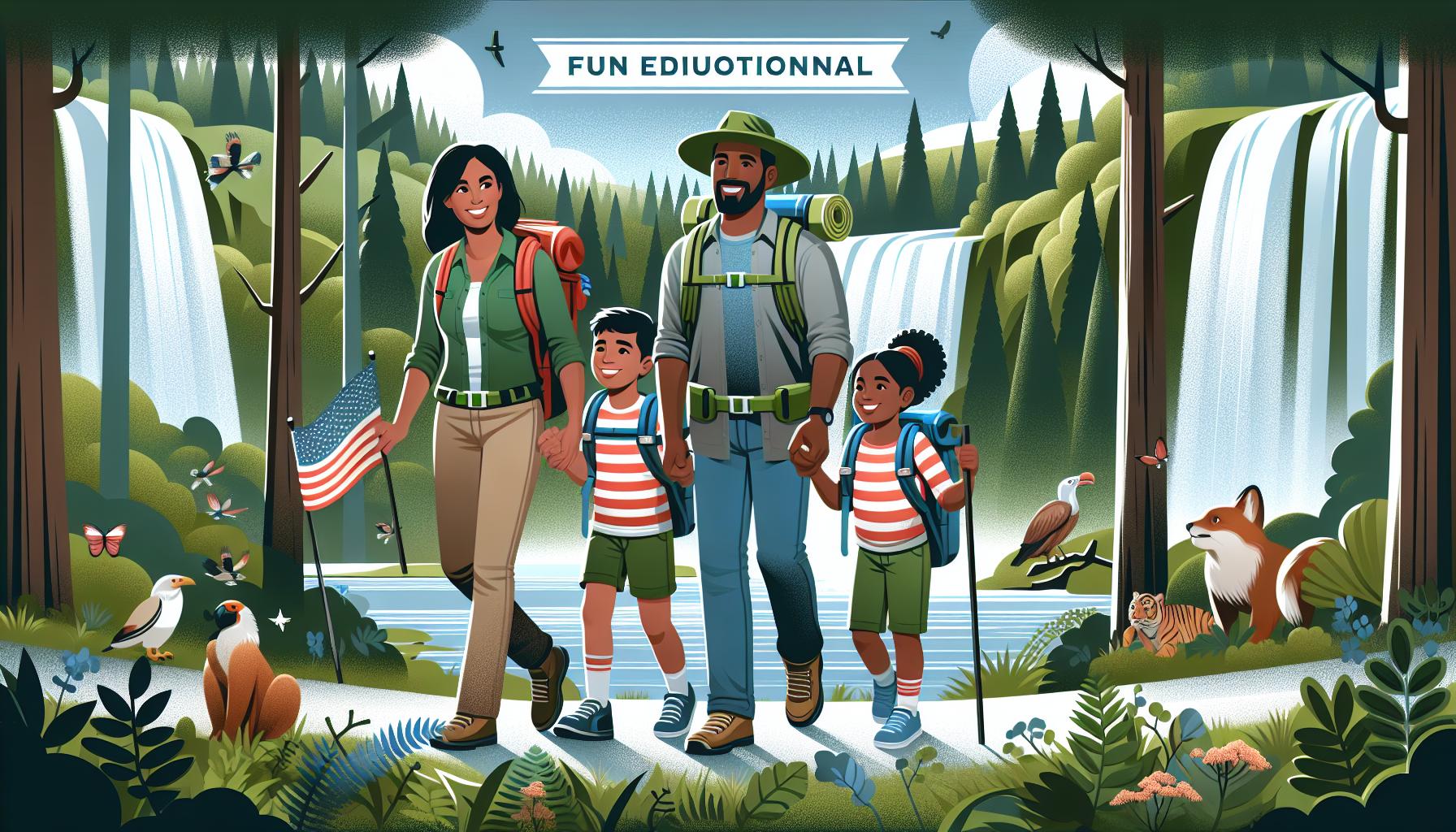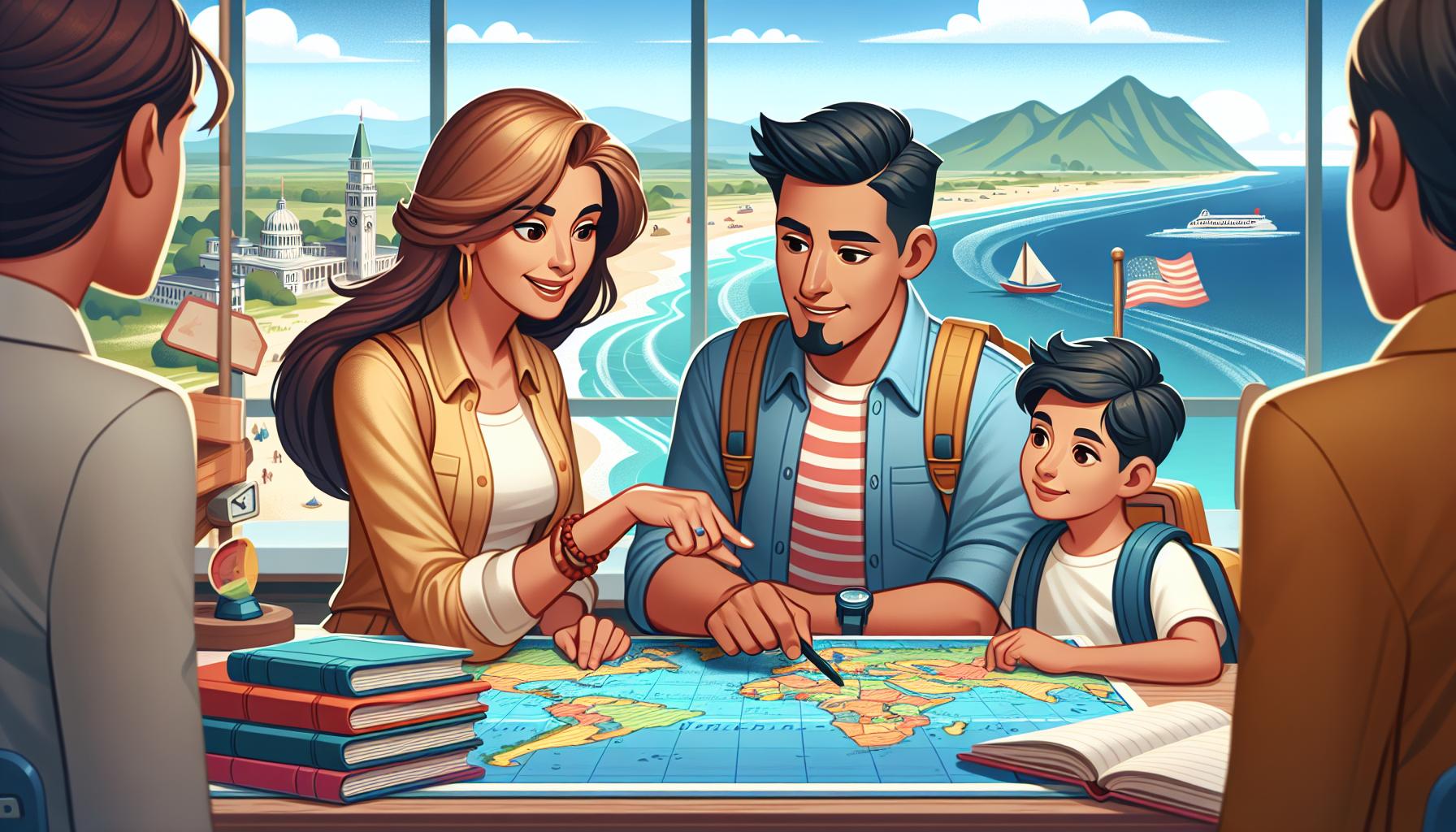
Key Takeaways
- Homeschooling while traveling combines education with real-world experiences, making lessons more engaging and memorable.
- National parks, historical landmarks, and international destinations offer hands-on learning opportunities in subjects like science, history, and culture.
- Planning homeschooling trips involves setting clear educational goals, creating flexible itineraries, and managing budgets effectively.
- Digital tools and portable resources enhance learning on the go, providing a balance between structured and spontaneous educational activities.
- Incorporating fun and interactive elements, like local traditions or outdoor adventures, keeps children motivated and excited about learning.
- Real-life stories from traveling families highlight how combining exploration with homeschooling fosters curiosity, global awareness, and family bonding.
Travel and learning go hand in hand, especially when we’re homeschooling. The world becomes our classroom, offering endless opportunities to teach history, science, art, and culture in ways that textbooks simply can’t. But how do we turn a trip into an enriching educational experience without losing the joy of exploration?
Whether we’re exploring national parks, diving into local traditions, or visiting museums, travel gives us the chance to make lessons come alive. It’s about sparking curiosity and creating memories that stick with our kids for years to come. What better way to learn than by experiencing it firsthand?
So, how do we plan trips that balance education and adventure? Let’s dive into some practical and inspiring ideas to help us create unforgettable journeys that teach, excite, and bring our families closer together.
Benefits Of Homeschooling While Traveling
Homeschooling during travel offers children an engaging and immersive educational experience. It allows us to teach valuable lessons right where history, science, or art comes alive.
Flexibility In Learning
Travel-based homeschooling accommodates diverse learning styles and interests. We can adjust lesson plans to match our schedule, focusing on topics relevant to the places we explore. For example, exploring Paris can inspire history and art lessons centered on the Renaissance. Learning outside the constraints of a traditional classroom also helps children focus on subjects at their own pace, whether they’re tackling math challenges or building language skills. How can a place you’ve visited shape your child’s learning today?
Hands-On Educational Experiences
Travel provides children with real-world lessons they can’t always get from textbooks. Visiting natural landmarks teaches geology, ecology, and geography with striking clarity. Exploring cultural festivals introduces customs, music, and cuisines that expand global awareness. Museums, aquariums, and historical sites are also unparalleled in sparking curiosity. Engaging with locals adds opportunities to practice new languages and understand different perspectives. What better way to enhance understanding than seeing and experiencing it firsthand?
Strengthening Family Bonds
Homeschooling while traveling creates shared memories that strengthen family relationships. Time spent exploring together fosters collaboration, communication, and trust. Whether hiking through a national park or discovering a historic town, every moment becomes a chance to connect. Joint problem-solving, like figuring out itineraries, also builds teamwork. Isn’t it fulfilling to learn and grow together while exploring new horizons?
Best Destinations For Homeschooling Travel

Exploring the right destinations can transform homeschooling into an inspiring adventure. Visiting educational sites offers children an opportunity to connect with subjects in meaningful ways. Where should you begin?
National Parks And Natural Wonders
National parks provide immersive environments to study science, geography, and ecology. Children can witness ecosystems, geological formations, and wildlife firsthand. For example, exploring Yellowstone introduces geothermal features and wildlife conservation, while visits to the Grand Canyon emphasize erosion and natural history. Hiking trails and park tours often include ranger-led programs tailored to various age groups, making lessons interactive.
Natural wonders like Niagara Falls or the Great Smoky Mountains combine adventure with learning. These locations encourage discussions about weather patterns, water cycles, and environmental preservation. Incorporating journals or sketchbooks during visits can enhance observation and reflection skills.
Historical Landmarks And Cultural Sites
Historical landmarks bring history lessons to life by connecting students to the past. Walking through Independence Hall or visiting battlefields like Gettysburg deepens understanding of pivotal events. These experiences help children see history beyond textbooks while fostering critical thinking.
Cultural sites, such as Native American reservations or the vibrant French Quarter in New Orleans, highlight traditions and artistic heritage. Engage with local guides or artists to learn about regional customs, storytelling, or crafts. Activities like historical reenactments or museum tours create hands-on learning opportunities.
International Travel Opportunities
International destinations expand perspectives by introducing diverse cultures, languages, and traditions. European capitals like Rome and Athens offer lessons in ancient civilizations and art history through iconic landmarks like the Colosseum or the Parthenon. Exploring these sites helps children build connections with global history.
Regions in Asia or South America allow families to dive into ecosystems like rainforests or historical sites such as Machu Picchu. These destinations provide immersive experiences, whether learning about endangered species or ancient innovation. Learning a few basic words in another language before traveling enhances cultural respect and communication.
No matter which destinations you choose, integrating local experiences fosters curiosity and lifelong learning. Where will your next homeschooling adventure take you?
Planning Your Homeschooling Travel

Organizing homeschooling travel combines education and discovery. A clear approach helps balance learning opportunities with family adventures.
Setting Educational Goals
Defining what we want our children to gain from the trip creates focus. Are we exploring historical events, studying ecosystems, or learning new languages? Identifying these objectives shapes the places we visit and the resources we bring. For example, a trip to a historical battlefield can center on history and storytelling, while visiting coastal regions can integrate marine biology and environmental studies. Clear goals align activities with learning priorities.
Creating A Flexible Itinerary
A well-structured but adaptable plan allows productive learning while embracing spontaneity. We can research key locations, educational programs, and local events before the trip. Organizing visits to museums, nature reserves, or cultural festivals on specific days creates a framework. At the same time, allocating unplanned hours lets us explore unique opportunities like a farmer’s market or community gathering we might discover in the moment. This balance makes the experience educational and enjoyable.
Managing Budget And Resources
Traveling while homeschooling requires thoughtful financial planning. Allocating funds to cover transportation, accommodations, and educational activities helps manage costs. Using free or discounted programs at national parks, cultural centers, or libraries can stretch our budget. Packing essential supplies, like notebooks, reference guides, or tablets loaded with educational apps, reduces expenses during the trip. Prioritizing affordable destinations or offseason travel options further controls costs while keeping the focus on immersive learning.
Tips For Successful Homeschooling On The Road
Keeping education effective while traveling requires a mix of preparation and flexibility. By focusing on adaptable strategies, we can create an enriching experience for the whole family.
Adapting To Different Learning Environments
Learning in unfamiliar settings introduces valuable opportunities. Whether studying in a park, museum, or hotel room, we can build lessons around the environment. For instance, a visit to a historical site could inspire discussions about past events, while a natural landscape offers a chance to explore science topics.
Carrying portable learning tools, like notebooks or educational flashcards, supports lessons anywhere. Asking thoughtful questions during outings—like, “What do you think caused these rock formations?”—keeps kids engaged. Rotating between structured lessons and informal, observational learning makes transitions between locations easier.
Leveraging Online Tools And Resources
Digital tools offer access to lessons even on the go. Platforms with educational videos or subject-specific tutorials can help reinforce core topics. We can use apps for math practice, language studies, or virtual museum tours to complement in-person learning.
Downloading resources in advance prepares us for areas with limited internet. Many websites and apps provide offline options, such as interactive games or readings. Combining virtual tools with real-world exploration, like completing an online art lesson after visiting a gallery, strengthens the learning connection.
Maintaining A Balance Between Learning And Fun
Travel offers chances to blend education with adventure. Emphasizing fun elements—like treasure hunts at a historical site or cooking local dishes—keeps learning exciting. We can involve our children in planning outings by asking, “What would you like to explore today?” This encourages curiosity and ownership of the experience.
Scheduling time for both activities and rest keeps everyone energized. If mornings focus on lessons, afternoons can include free play or sightseeing. Prioritizing quality over quantity means focusing on a few meaningful experiences instead of an overload of activities.
Inspiring Stories From Homeschooling Travelers
Real-life stories from traveling families provide both encouragement and practical ideas for homeschooling on the road. These narratives prove how combining education with exploration creates lifelong memories and transformative learning experiences. Have you ever wondered how other families approach this adventurous way of learning?
One family, exploring the coastlines of North America, turned their trip into a marine biology lesson. They observed tidal pools, documented wildlife habitats, and even participated in local beach clean-ups to connect environmental studies with real-world impact. Their children described the experience as unforgettable, recalling the vibrant ecosystems they studied firsthand.
Another homeschooling family shared how a historical trail in Europe became their classroom. They walked through centuries-old landmarks, delved into stories of past civilizations, and deepened their understanding of major historical events. The parents expressed how the immersive journey captivated their children’s curiosity far more than traditional teaching methods ever could.
In Asia, a family traveling through bustling markets and tranquil villages introduced their kids to new languages and cuisines. Through daily interactions with locals, the children practiced conversational phrases, learned the cultural significance of food, and gained confidence in adapting to different environments. The parents remarked on how their kids’ perspectives broadened with every encounter.
One mother recalled how homeschooling during a year-long road trip across national parks fostered a love for science. Her children learned about geology by studying rock formations, observed wildlife behavior in natural settings, and even journaled about ecosystems they explored. She shared how fieldwork kept her family engaged and ignited her children’s passion for science in unexpected ways.
These stories remind us that traveling while homeschooling is more than reaching destinations. It’s creating moments where learning feels alive, collaborative, and deeply personal. What could you imagine your family discovering on such a journey?
Conclusion
Homeschooling while traveling opens up endless opportunities to turn the world into a vibrant classroom. It’s a chance to spark curiosity, nurture creativity, and build lasting family memories through shared experiences. By embracing the flexibility of this lifestyle, we can create meaningful learning moments that go far beyond textbooks.
Whether it’s exploring cultural traditions, diving into natural wonders, or walking through history, every journey becomes a stepping stone to deeper understanding. With thoughtful planning and a willingness to adapt, we can make education an exciting adventure for the entire family. Let’s keep exploring, learning, and growing together.
Frequently Asked Questions
What are the benefits of combining travel with homeschooling?
Combining travel with homeschooling allows children to experience immersive learning by connecting lessons to real-world environments. It fosters curiosity, enhances understanding, and accommodates various learning styles. Additionally, it strengthens family bonds through shared experiences and creates lifelong memories.
How does travel enhance education for homeschoolers?
Travel allows children to learn through hands-on experiences such as exploring natural landmarks, engaging in cultural festivals, and visiting historical sites. It brings abstract concepts to life and provides a dynamic, interactive learning environment beyond traditional textbooks.
What are some educational destinations for homeschooling while traveling?
Great destinations include national parks for science and ecology, historical landmarks for history lessons, and cultural festivals for exploring art and traditions. International travel offers opportunities to learn about new languages and diverse cultures, expanding global perspectives.
How do I balance education and fun while homeschooling on the road?
Plan a flexible itinerary that balances structured visits to educational sites with downtime for exploration and relaxation. Involving children in planning and incorporating fun activities alongside lessons ensures a balance of enjoyable and meaningful experiences.
What tools or resources are helpful for homeschooling during travel?
Portable resources like notebooks, flashcards, and tablets are practical for road schooling. Use educational apps and online resources to supplement lessons. Prepare offline materials as backups for areas with limited internet access.
How do I plan homeschooling trips effectively?
Start by setting clear educational goals to shape your itinerary. Plan visits to educational sites while allowing room for spontaneous exploration. Focus on budget-friendly activities, pack essential learning tools, and remain flexible in lesson planning and daily schedules.
Is homeschooling while traveling suitable for all ages?
Yes, homeschooling while traveling can be tailored for learners of all ages. Younger children enjoy hands-on activities like nature walks, while older kids can engage deeply with topics like history, ecology, and cultural studies.
How can traveling as a family enhance learning experiences?
Traveling together strengthens bonds by fostering collaboration and shared experiences. It turns lessons into interactive adventures and encourages teamwork, helping the entire family grow closer while learning together in exciting, real-world contexts.
Are homeschooling trips expensive to plan?
Homeschooling trips can be as budget-friendly as you’d like. Use strategies like staying in affordable accommodations, cooking meals, and exploring free or low-cost educational sites like national parks and local museums. Prioritize experiences over extravagant costs.
What kind of lessons work best during travel-based homeschooling?
Lessons related to history, science, ecology, art, and culture are particularly impactful. Tying learning to specific destinations—like studying marine biology by the coast or history at landmarks—helps concepts come alive for children in meaningful ways.

